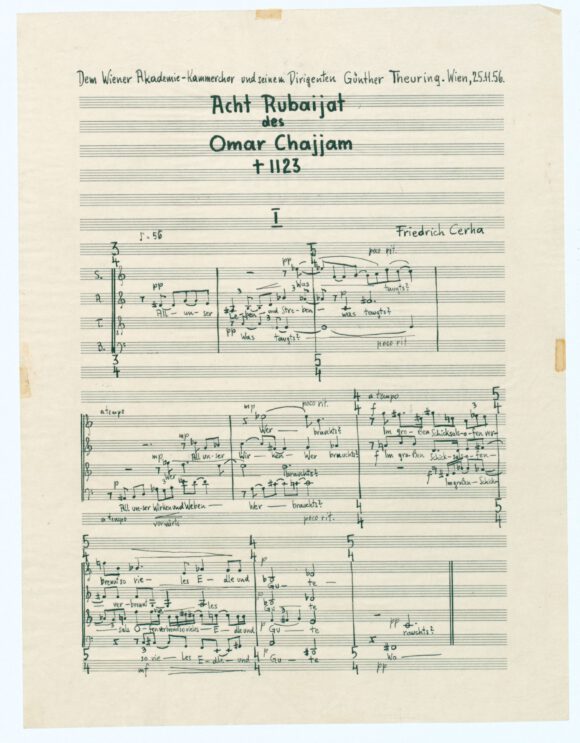Untersuchung zur Rezeption persischer Lyrik in der europäischen Kunstmusik am Beispiel der Werke von Saʿdī, Ḥāfeẓ und ʿOmar Ḫayyām. Elgaz Pegah. Heidelberg : Universitätsbibliothek Heidelberg, 2024.
Archives
Zehn Rubaijat des Omar Chajjam
Zehn Rubaijat des Omar Chajjam
 The research project “Cerha Online”, led by musicologist Univ.-Prof. Dr. Matthias Henke, sets out to make Friedrich Cerha’s work as accessible as possible to the broad public. The project tells the story behind Cerha’s composition, elucidated with illustrations from Dulac’s Rubáiyát, scores, audio-samples and quotes.
The research project “Cerha Online”, led by musicologist Univ.-Prof. Dr. Matthias Henke, sets out to make Friedrich Cerha’s work as accessible as possible to the broad public. The project tells the story behind Cerha’s composition, elucidated with illustrations from Dulac’s Rubáiyát, scores, audio-samples and quotes.
Cerha Online
Beperking als uitdaging: kwatrijnen van Omar Khayyam door Karin van der Knoop
Beperking als uitdaging: kwatrijnen van Omar Khayyam door Karin van der Knoop. Hilbrand Adema.
Toonkunst nieuws, (1997), (juni)
Interview met Karin van der Knoop, hoofdvakstudente compositie aan het Conservatorium van Amsterdam, over haar compositie “Kwatrijnen van Omar Khayyam”, voor sopraansolo, drie fluiten, basklarinet en percussie, op teksten vertaald door J.H. Leopold.
Khayyam, Omar x. Musical works based on the Rubaiyat of Omar Khayyam
Khayyam, Omar x. Musical works based on the Rubaiyat of Omar Khayyam. W.H. Martin, S. Mason.
Encyclopaedia Iranica, Online Edition, July 15 2009
The enduring popularity of the verses in the Rubaiyat of Omar Khayyam is reflected in the large number of musical works they have inspired. Not all the works were small-scale pieces. One of the best-known large-scale compositions is Sir Granville Bantock’s (1868-1946) ‘Omar Khayyam’ (1908-10) for soloists, chorus and orchestra. It is a three-part work, setting all the 101 quatrains from FitzGerald’s fifth edition.
Sufi symbolism in Tolib Shakhidi’s televised ballet The Rubaiyat of Omar Khayyam
Sufi symbolism in Tolib Shakhidi’s televised ballet The Rubaiyat of Omar Khayyam. Marina N. Drozhzhina, Sitora D. Davlatova
Music Scholarship, 2018, Nr. 1, pp. 66-73